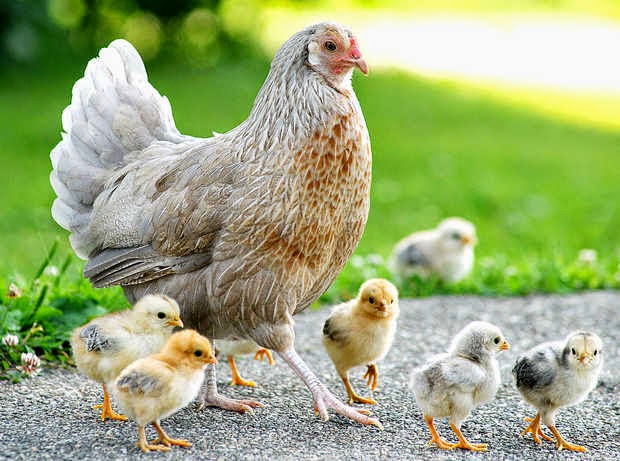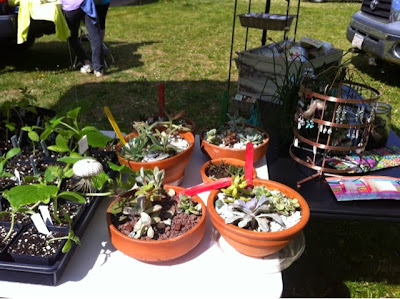Many things were learned this spring on the homestead. Like free range chickens and gardens don't mix, and having an infant really puts a damper on production and the 25 projects that you thought you could get done are probably not going to get done till she's in high school.
First off let me just say, I love having the ladies roam free, they're happy eating bugs and I'm happy cause there's less bugs. But if you spend lots of time and money on flower and veggie gardens, then you will not be happy when your plants get torn up while said chicken is looking for said bug and you will not be thrilled that all the mulch you put down around the plants is spread all over the lawn.
That being said, if you want to keep your sanity and your hens alive and safe from you and predators then keep them in a run or get a chicken tractor and do yourself a favor and clip their wings so the don't hop the fence or cover the top of their enclosure too.
This a a lesson I learned too late. Wanda the wondering Silver Laced Wondatte wondered away, hopefully not out foxed by Foxy Loxy, or fallen prey to some other predictor. Maybe by some miracle she'll wonder back home. Although I've almost made her into chicken soup several times for hopping the fence and tearing up my garden, I still wouldn't want her to be fox food. Here's to hoping you'll return, you've always been my favorite ever since you were a chick.
Starting plants from seed indoors under lights just isn't the same as starting them in a greenhouse, another lesson learned. I'm not wasting my time and energy on the majority of seeds until I get a green house cause it's just not worth it. Most plants got leggy and just didn't preserver the way they would in a greenhouse. Plus I hate the way the seedlings end up taking over the house and it all ends up everywhere.
Some things did good like the lettuce that survived the little greenhouse stand toppling over, another lesson learned, and the squash plants but other things like peppers and eggplants just did crappy. Nothing beats genuine, all natural sunlight and that's that and the greenhouse stand doesn't quite cut the mustard. So until I get a greenhouse plant production is only specified to a few things and that is that.
Tasks that seem like they'd be easy to get done generally aren't, especially when you have an infant at home that won't take a bottle and wants constant attention. Gardening only gets done while baby is sleeping or for the little while toys are entertaining or when daddy is holding the little stinker. Oh we're going into July and the gardens still aren't done being mulched and the rows that seeds were planted in that never germinated and are still laying empy because you can't seem to get back out there cause your teething monster of a child won't stop screaming? Oh yeah that's just all part of it.
Expanding the garden and starting a small homestead business with a new baby is tougher than you think it will be before you actually have a baby, lesson learned. Babies are a lot of work, especially this little punk-in of mine.
Projects like setting up a farm stand also prove to be one of those things that in my mind I think of as being nothing, a piece of cake right? All you've got to do is set up a little stand and put your produce and stuff in it with a cash box and you're all set right? Wrong.
Apparently you need a permit and before you can get a permit you've got to get approved by the building inspector and see if you're properly zoned for it. And to make it that much easier for you the building inspector is only in one day a week and so isn't the town clerk and it's not the same day either. And to think I just thought I could put my veggies out front like it was nothing. Still dealing with this little farm stand lesson, what a bureaucratic nightmare.
Thinking that you will be able to attend multiple farmers markets with a baby is also another thing that is just not going to happen unless you've got an easy baby that can be without mommy and her boobies for hours multiple times a week and daycare. I can only seem to get daddy daycare one day a week and even that's a challenge. Maybe next year when she's older I'll be able to do more. Also not all markets are created equally some you just do better at than others and some cost more to do than others and trying different ones out to see how you do really is the best thing to do when deciding on which you will attend regularly. Also regularity is key to success at markets as well people like to know you'll be there and will be more likely to frequent your booth when you're there every week.
Another good lesson is to take help when offered. I'm always trying to be so independent, not wanting to put anyone out or have to rely on someone but you know help is great and when it's offered just take it! You don't need to be super woman and you've got nothing to prove, so when the kid at Chipotle asks if he can help you carry your food over to your table take it, instead of saying no I've got it while juggling your wallet, keys, change, baby in her car seat, and your tacos and drink cup, to then turn around and dump the damn tacos all over your poor child in her car seat. It's much easier to take the help then to then go get the diaper bag out of the car and change and clean taco out of said seat and off baby on the bathroom floor of Chipotle because they don't even have changing tables, thank god for the changing mat in the diaper bag, and then go and get more tacos. So yeah take the freaking help when it's offered please and save yourself the headache.
This just about sums up the big lessons learned over here at Mother Hen's Homestead this spring. Hopefully reading some of my mishaps will keep you from having to learn these same lessons on your own.
Best.
~Megan~















































